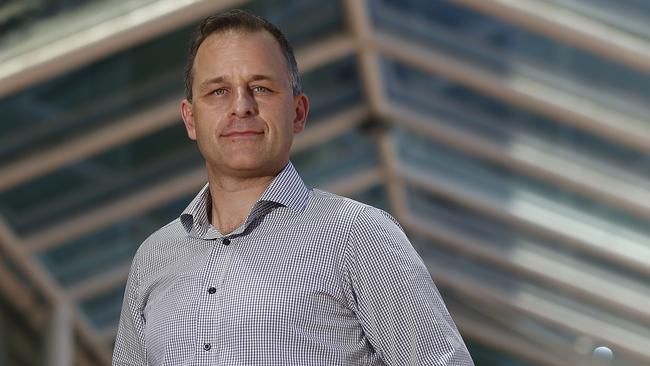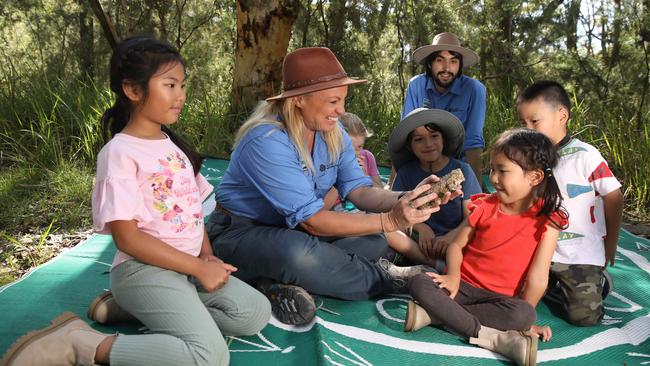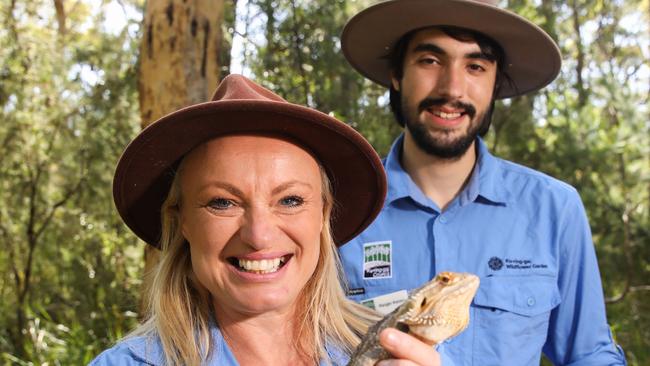Here’s what your local councils are doing for sustainability
Our councils are still doing rubbish and roads – just a bit differently. We investigate the incredible environmental initiatives in your north shore neighbourhood.

Mosman
Don't miss out on the headlines from Mosman. Followed categories will be added to My News.
Lane Cove Mayor Andrew Zbik is struggling to get solar panels on his roof.
Even though his environmentally minded neighbours in adjoining houses are eager for a slice of the action, he’s hit hurdle after hurdle.
“I live in a townhouse and they say they can’t hook me up individually because I’m too far from their infrastructure,” Zbik says.
“As a strata scheme, we basically have to be registered as an energy entity otherwise we can only use it to power common areas, which in our case is 16 LED lights.”
Unwrapping the red tape around solar power for the individual consumption of households in strata buildings is an issue facing not only Lane Cove but all of Australia as we make our transition to renewable energy.
But rather than dwell on what he can’t do, Zbik is focused on what he can, and thanks to the foresight of his predecessors who implemented a then unheard of sustainability levy about 25 years ago, Lane Cove is ahead of the curve.
The council’s ambitious targets, based on levels in 2016, are to achieve an 80 per cent reduction in emissions and no net increase in water use by 2036.
To meet these goals it has implemented initiatives including laying recycled crushed-glass asphalt in Greenwich’s O’Connell St; switching 1100 street lights to LED; installing a new electric vehicle charging station at The Canopy, which is up to 10 times faster than the existing chargers; and implementing the HarbourCare program with almost 800 volunteers removing more than a tonne of rubbish per year.

Lane Cove has also decked out the new public pool with 162 solar panels, which save five tonnes of CO2 in one month alone, and upgraded the filters which reduce weekly water usage from 22,000 litres to just 2000 litres.
In Mosman, Mayor Carolyn Corrigan has been poring over the results of the council’s household food waste audit.
As a result, changes are already underfoot.
“We recently distributed sustainability and recycling information to residents and regularly participate in innovative trials such as an Australian-first program trialling kerbside collection of aluminium coffee capsules as well as coffee cup recycling or reuse programs,” Corrigan says.
Mosman is also accelerating the rollout of LED lighting in council infrastructure and subsidising the recycling of aged solar panels from residential properties.
“Encouraging the uptake of electric vehicles is another key part of our strategy. Council’s Evie Networks fast electric vehicle charger in Mosman Square Car Park has proven very popular and will soon pass a significant milestone with its 1000th charge,” Corrigan says.
“The charger has helped curb Mosman’s carbon footprint and at the recent rate of usage saves about 355kg in emissions every week.

“Mosman Council has also embraced the shift to electric, taking delivery of its first fully electric fleet vehicle and launching a trial of an electric bike as part of its strategy to continue to reduce CO2 emissions.
“When factoring in greenhouse gas emissions from food production, by some estimates electric bicycles are the least carbon-intensive mode of transport, even lower than walking, because of the energy efficiency of being on two wheels.”
The council will also be maintaining and expanding on its existing 35 per cent tree canopy coverage and focusing on planting in hard surface areas to reduce the heat island effect and increase habitat links.
The heart of North Sydney’s sustainability push is at the now decommissioned coal transfer depot – a place that once contributed to climate change.
Now The Coal Loader Centre for Sustainability is a vibrant hub on the cutting edge of green technology.
Mayor Zoe Baker says North Sydney Council has been a leader in sustainable technology and initiatives for more than 20 years.
“I believe it’s council’s role to lead by example for the community when it comes to creating sustainable habits and our many projects demonstrate that we are taking a holistic approach to sustainability,” Baker says. “I am particularly proud of The Coal Loader Centre for Sustainability, which has been developed on sustainable principles and showcases what can be achieved. Our community has embraced the centre, which is not only a hub for sustainable learning, but also a popular gathering point.”

North Sydney boasts one of the largest gross pollutant trap programs in Sydney with 26 devices preventing more than 500 tonnes of rubbish entering the harbour each year.
That’s not all – the rubbish collected in the trap is sorted and recycled with the bio-waste left over turned into soil.
Harbour health is also prioritised through the Living Seawalls initiative, which involves the installation of marine “habitat tiles”.
Stormwater from street run-off is diverted to the Cammeray Dam catchment area and filtered and treated before reuse.
Every year 25 million litres is rescued and used on St Leonards Park and the ovals, Primrose sportsfields and Tunks and Forsyth parks.
Water is also saved by way of raingardens, which remove microparticles and pollutants through the type of plants used.
By January 2023, the equivalent of all the electricity that North Sydney Council utilises will be from renewable sources such as local solar and wind farms.
Ku-ring-gai Council aims to be net zero by 2040.
Mayor Jeff Pettett says it has already made good headway by introducing hybrid and electric vehicles to the fleet, installing solar panels on all major public buildings and introducing a ban on single-use plastic in its operations.
“We want to help the community reach this goal by making alternative transport more accessible, providing additional cycle routes and the availability of electric vehicle charging points,” he says.
Late last year, the council publicly exhibited a draft Water Sensitive City policy, which addresses the issues of water conservation, protecting the health of local waterways and their biodiversity.

“The policy also takes account of the shift required in community water use, such as reducing hard surfaces in new developments, increasing the use of recycled water and encouraging water-sensitive garden design,” Pettett says.
Last year also saw the debut of a new waste service that offers residents more recycling opportunities for items including white goods and other metal waste, electronic waste such as computers, and mattresses.
Council collections can be booked by residents up to four times a year.
Ku-ring-gai offers environmental community grants of up to $50,000 a year to groups, schools and residents for small-scale environmental projects such as vegetable gardens, bush care, water quality monitoring, weed removal from creeks and sustainable garden pest management.
Right now, the council is preparing a detailed design for a new cultural and environmental education centre near St Ives Showground.
And just this month, Ku-ring-gai was recognised for its environmental education programs at the Wildflower Garden and nominated as a finalist in the Sustainable Cities category of the Keep Australia Beautiful awards.
Willoughby’s diverse urban and natural landscape is at the forefront of the Green City Plan 2028.
The plan provides a deadline to reduce emissions, promote sustainable lifestyles and practices, and protect natural environments.
Mayor Tanya Taylor says the Green City Plan flows on from the council’s decision in late 2019 to declare a climate emergency.
“Around 12,000 people took part in more than 510 events and workshops on how to live sustainably over the past four financial years and this incredible response is delivering results,” Taylor says.

“In the last financial year 51 per cent of residential waste was diverted from landfill, households are using less water each year and people are helping to reduce emissions by embracing solar power.”
The impressive initiatives championed by Willoughby include the RecycleSmart pilot, which allows residents to have textiles, batteries, soft plastics and e-waste collected from their homes and recycled locally for free.
The solar bulk buy scheme offers residents a great value deal when converting their homes to renewable energy and the lucrative discount has so far led to a 10 per cent increase in uptake.
The council also funds a free consultancy service to design a solar system for residential strata and commercial buildings.
Back in Lane Cove, while he might have to wait a bit longer for his solar panels at home, Zbik is already on the front foot of the council’s next environmental initiative.
One of the biggest concerns residents come to him with is food waste, so he was thrilled when they received grant money to band together with neighbouring councils to start their Food Organics and Garden Organics bin trial.
“It’s due to commence soon. We’re interested to see what format works best for the biggest uptake and the results will definitely inform our more permanent solutions,” Zbik says.
“I know first hand people in our area want strong action on climate change and that’s exactly what we are going to deliver.”
Ku-ring-gai wildlife warriors report for duty
Do you know about the habitat of blue tongues? What about the favourite plants of stick insects?
The kids of Ku-ring-gai can tell you thanks to their incredible Junior Rangers program at Wildflower Garden.
The Junior Rangers is a beloved after school activity attended by 30 primary school aged children each week at St Ives.
A love of the environment is instilled in kids early in Ku-ring-gai with a popular nature play class also at the Wildflower Garden for children aged under six recently receiving a highly commended in the Keep Australia Beautiful awards.

Council team leader of venues, Kathryn McHugh, said Junior Rangers had been running for the past six years even continued during lockdown via Zoom.
“The Junior Rangers program is designed to engage children in a natural environment, and increase their appetite for wonder,” Ms McHugh said.
“Each week we explore different aspects and themes of the natural world to create further
exploration in areas that are not so commonly taught.
“Time in nature grows resilience, self confidence and initiative.”
The nature play and Junior Rangers have become so popular, Ku-ring-gai council is now looking to launch a related citizen science pathway for secondary school children over the coming months.



